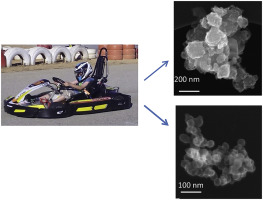当前位置:
X-MOL 学术
›
Atmos. Environ.
›
论文详情
Our official English website, www.x-mol.net, welcomes your
feedback! (Note: you will need to create a separate account there.)
Particulate matter in air at indoor go-kart facilities in Bavaria, Germany
Atmospheric Environment ( IF 4.2 ) Pub Date : 2018-11-01 , DOI: 10.1016/j.atmosenv.2018.09.010 Marina Sysoltseva , Richard Winterhalter , Janine Wolf , Knut Berlin , Saskia Eckert , Ludwig Fembacher , Wolfang Matzen , Lutz Nitschke , Christina Scheu , Hermann Fromme
Atmospheric Environment ( IF 4.2 ) Pub Date : 2018-11-01 , DOI: 10.1016/j.atmosenv.2018.09.010 Marina Sysoltseva , Richard Winterhalter , Janine Wolf , Knut Berlin , Saskia Eckert , Ludwig Fembacher , Wolfang Matzen , Lutz Nitschke , Christina Scheu , Hermann Fromme

|
Abstract Indoor go-karting is a popular free time activity for many people, including adults and children. Particulate matter from engine emissions, brake and tire debris and gaseous pollutants are important sources of air pollution. Exposure to these air pollutants is associated with health-related problems. In this study, the exposure of employees and spectators to particulate matter was measured in 8 indoor go-kart facilities (6 facilities used gasoline, one used liquid gas and one used electricity for their go-karts). The mass concentrations of particulate matter were continuously analyzed. Particles were sampled and analyzed by inductively coupled plasma mass spectrometry and electron microscopy coupled with energy-dispersive X-ray spectroscopy. The mean PM10 concentrations ranged between 4.9 and 34.9 μg/m³ for workplaces and 5.6 and 28.4 μg/m³ for spectator areas. The mean PM2.5 concentrations measured in workplaces ranged from 2.3 to 29.2 μg/m³ and from 2.4 to 27.4 μg/m³ in the spectator areas. The highest PM10 and PM2.5 concentrations were measured at the liquid gas go-kart facility and at go-kart facilities with the maximum number of go-karts running simultaneously. The electric go-kart facility showed high PM10 concentrations but low PM2.5 values. The highest particle number concentration was measured in the workplace of the facility using liquid gas go-karts (2.7 × 105 particles/cm³), and the lowest concentration at both measurement points of the electrical go-kart facility (1.8 × 104 particles/cm³). Metals such as copper, zinc, strontium, barium, aluminum, calcium, manganese, iron and nickel were found in nearly all samples with help of inductively coupled plasma mass spectrometry. The most abundant metal was iron, with concentrations up to 5.6 μg/m3 (electric go-kart facility). Electron microscopic investigations showed high concentrations of soot in all samples, except for the samples of the electric go-kart facility. Additionally, agglomerates with iron and other metals were found in all samples. To summarize, electric go-karts, combined with a good ventilation system, seem to be more suitable for indoor use.
中文翻译:

德国巴伐利亚室内卡丁车设施空气中的颗粒物
摘要 室内卡丁车是包括成人和儿童在内的许多人的流行休闲活动。来自发动机排放物、刹车和轮胎碎片以及气态污染物的颗粒物是空气污染的重要来源。暴露于这些空气污染物与健康相关问题有关。在这项研究中,员工和观众在 8 个室内卡丁车设施(6 个设施使用汽油、1 个使用液化气和 1 个使用电力的卡丁车)中测量了颗粒物暴露情况。连续分析颗粒物的质量浓度。通过电感耦合等离子体质谱法和电子显微镜结合能量色散 X 射线光谱法对粒子进行采样和分析。工作场所的平均 PM10 浓度介于 4.9 和 34.9 μg/m³ 之间,5.6 和 28 之间。观众区为 4 μg/m³。在工作场所测得的平均 PM2.5 浓度范围为 2.3 至 29.2 微克/立方米,观众区为 2.4 至 27.4 微克/立方米。在液化气卡丁车设施和同时运行的卡丁车数量最多的卡丁车设施中测量到的 PM10 和 PM2.5 浓度最高。电动卡丁车设施显示出高 PM10 浓度但低 PM2.5 值。使用液化气卡丁车(2.7 × 105 颗粒/cm³)在设施的工作场所测得的颗粒数浓度最高,电动卡丁车设施的两个测量点的最低浓度(1.8 × 104 颗粒/cm³) )。金属,如铜、锌、锶、钡、铝、钙、锰、在电感耦合等离子体质谱法的帮助下,几乎所有样品中都发现了铁和镍。最丰富的金属是铁,浓度高达 5.6 μg/m3(电动卡丁车设施)。电子显微镜研究表明,除了电动卡丁车设施的样品外,所有样品中的烟灰浓度都很高。此外,在所有样品中都发现了铁和其他金属的附聚物。总而言之,电动卡丁车加上良好的通风系统,似乎更适合室内使用。在所有样品中都发现了铁和其他金属的附聚物。总而言之,电动卡丁车加上良好的通风系统,似乎更适合室内使用。在所有样品中都发现了铁和其他金属的附聚物。总而言之,电动卡丁车加上良好的通风系统,似乎更适合室内使用。
更新日期:2018-11-01
中文翻译:

德国巴伐利亚室内卡丁车设施空气中的颗粒物
摘要 室内卡丁车是包括成人和儿童在内的许多人的流行休闲活动。来自发动机排放物、刹车和轮胎碎片以及气态污染物的颗粒物是空气污染的重要来源。暴露于这些空气污染物与健康相关问题有关。在这项研究中,员工和观众在 8 个室内卡丁车设施(6 个设施使用汽油、1 个使用液化气和 1 个使用电力的卡丁车)中测量了颗粒物暴露情况。连续分析颗粒物的质量浓度。通过电感耦合等离子体质谱法和电子显微镜结合能量色散 X 射线光谱法对粒子进行采样和分析。工作场所的平均 PM10 浓度介于 4.9 和 34.9 μg/m³ 之间,5.6 和 28 之间。观众区为 4 μg/m³。在工作场所测得的平均 PM2.5 浓度范围为 2.3 至 29.2 微克/立方米,观众区为 2.4 至 27.4 微克/立方米。在液化气卡丁车设施和同时运行的卡丁车数量最多的卡丁车设施中测量到的 PM10 和 PM2.5 浓度最高。电动卡丁车设施显示出高 PM10 浓度但低 PM2.5 值。使用液化气卡丁车(2.7 × 105 颗粒/cm³)在设施的工作场所测得的颗粒数浓度最高,电动卡丁车设施的两个测量点的最低浓度(1.8 × 104 颗粒/cm³) )。金属,如铜、锌、锶、钡、铝、钙、锰、在电感耦合等离子体质谱法的帮助下,几乎所有样品中都发现了铁和镍。最丰富的金属是铁,浓度高达 5.6 μg/m3(电动卡丁车设施)。电子显微镜研究表明,除了电动卡丁车设施的样品外,所有样品中的烟灰浓度都很高。此外,在所有样品中都发现了铁和其他金属的附聚物。总而言之,电动卡丁车加上良好的通风系统,似乎更适合室内使用。在所有样品中都发现了铁和其他金属的附聚物。总而言之,电动卡丁车加上良好的通风系统,似乎更适合室内使用。在所有样品中都发现了铁和其他金属的附聚物。总而言之,电动卡丁车加上良好的通风系统,似乎更适合室内使用。











































 京公网安备 11010802027423号
京公网安备 11010802027423号